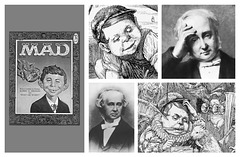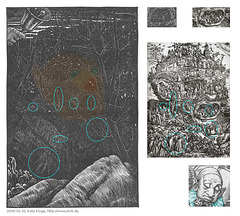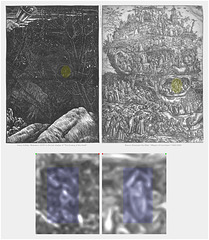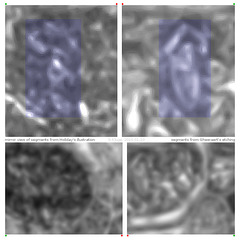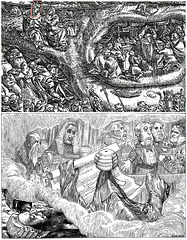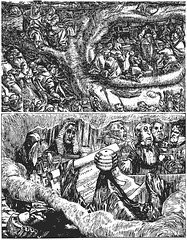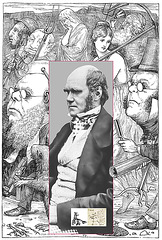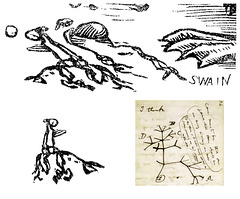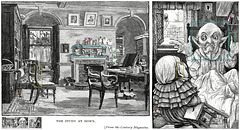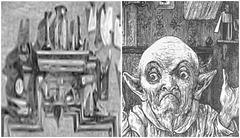
The Hunting of the Snark
Folder: The Hunting of the Snark
All Snark. (My Snark favorites are here: www.ipernity.com/doc/goetzkluge/album/410701)
Neuman, Butcher, Jowett
| |
|
|
Source for "Alfred E. Neuman": en.wikipedia.org/wiki/File:Mad30.jpg
After my Butcher/Jowett comparison I run into a page published by Art Neuendorffer . He discovered a resemblance between Henry Holiday's depiction of The Butcher in Lewis Carroll's The Hunting of the Snark and Alfred E. Neuman . Neuendorffer wrote: "When Mad Magazine was sued for copyright infringement, one defense it used was that it had copied the picture from materials dating back to 1911." Incidentially, my first copy of the The Hunting of the Snark was an American edition published in 1911.
But there also is www.facebook.com/photo.php?fbid=10201516021681606&set=o.115919138428537&type=1&stream_ref=10 (Jeffrey C. Hughes).
2017-09-24: It seems that Alfred E. Neuman and the Butcher are quite distant relatves only:
※ www.theparisreview.org/blog/2016/03/03/a-boy-with-no-birthday-turns-sixty
※ historylink.org/File/20210
Snark Hunt: Square One
| |
|
|
Illustration by Henry Holiday to The Hunting of the Snark (1876) and The Image Breakers (1566-1568) by Marcus Gheeraerts the Elder.
This is the first comparison which I made between a Snark illustration by Henry Holiday and another image. A second discovery followed. That is how the Snark hunt started in December 2008. At that time my dealing with Holliday's illustration perhaps was a bit too playful and some matches marked in this comparison are questionable. But it was a good start, also thanks to some encouragement by the Canadian Indian German cryptomorphist Snark illustrator Mahendra Singh , who at that time already (but unknowingly) worked like Henry Holiday (even though he doesn't like Holiday's illustrations too much). The difference: Holiday never talked about his allusions. Singh does so quite openly. Both artists have in common, that they not only create illustrations, they also teach how to see .
How did I run into the Snark ? The hunt is a kind of side effect of my work in work safety .
Holiday and Gheeraerts I
| |
|
|
Illustration by Henry Holiday to The Hunting of the Snark (1876, chapter The Vanishing ) and The Image Breakers (1566-1568) by Marcus Gheeraerts the Elder.
How does blurring help to compare the images? The Priest in the Mouth detail is displayed using two high resolution images (middle) which then again have been low pass filtered (bottom). That filtering helps to focus on larger structures.
This was the first allusion by Henry Holiday to another work of art which I discovered in December 2008.
Holiday and Gheeraerts I
| |
|
|
Illustrations by Henry Holiday (from The Hunting of the Snark ,1876) and Marcus Gheeraerts the Elder ( Allegory of Iconoclasts around 1567): In the "mouth" of Gheeraert's "head" a praying priest is depicted. The shape of the priest also is visible in the "mouth" of Holiday's vanishing "Baker".
This is not plagiarism. This is a puzzle in a picture similar to puzzles in textual artwork (poetry,novels etc.), where readers are challenged to detect references to other writers. Holiday may have used the shape of the priest in his own illustration in order to indicate to the beholder a relation to Gheeraert's illustration. Holiday also used other elements from Gheeraert's etching in his own work.
Priest in the Mouth
| |
|
|
[left]: mirrored view of details from in Henry Holiday's illustration The Vanishing to Lewis Carroll's The Hunting of the Snark (1876)
[right]: segments from Allegory of Iconoclasm by Marcus Gheeraerts the Elder (1566-1568)
Carroll's Barrister's Dream
| |
|
|
Redrawn image from a concept draft by C.L. Dodgson (aka Lewis Carroll). The original drawing was part of a lot consisting of an 1876 edition of the "Hunting of the Snark" and a letter (dated 1876-01-04) by Dodgson to Henry Holiday. The lot was auctioned by Doyle New York (Rare Books, Autographs & Photographs - Sale 13BP04 - Lot 553) offered in November 2013. The whole lot was sold for US$ 25000.
www.doylenewyork.com/asp/fullcatalogue.asp?salelot=13BP04+++553+&refno=++953647&image=2
Henry Holiday's depiction of a scene from the chapter "The Barrister's dream".
The Snark in your Dreams
| |
|
|
The lower image is the only Snark illustration by Henry Holiday which shows the Snark . However, in this case the beast appeared in The Barrister's dream . Therefore it is just a Dream Snark .
[top]: Detail from the etching (1566-1568) The Image Breakers by Marcus Gheeraerts the Elder.
[bottom]: Detail from the illustration (1876) by Henry Holiday to The Hunting of the Snark . Lewis Carroll (C. L. Dodgson) did not want Henry Holiday to depict the Snark in the illustrations to The Hunting of the Snark . But Holiday was allowed to let it appear veiled by its "gown, bands, and wig" in The Barrister's Dream .
Also in this case, Holiday pictorially alluded to the etching by Marcus Gheeraerts the Elder. In this comparison several shapes - see notes (1) to (5) - provide the beholder of the illustration with pictorial quotes which point to that etching.
This is just the place to repeat a textual quote which I like a lot:
"We have neglected the gift of comprehending things through our senses. Concept is divorced from percept, and thought moves among abstractions. Our eyes have been reduced to instruments with which to identify and to measure; hence we suffer a paucity of ideas that can be expressed in images and in an incapacity to discover meaning in what we see. Naturally we feel lost in the presence of objects that make sense only to undeluted vision, and we seek refuge in the more familiar medium of words. ... The inborn capacity to understand through the eyes has been put to sleep and must be reawakened."
(Rudolf Arnheim: Art and Visual Perception, 1974, p. 1)
Images like this could be used in class by arts teachers to reawaken that inborn capacity. This also is a training to make and discuss decisions based on incomplete information.
Am I wrong? Am I right?
"Only those questions that are in principle undecidable, we can decide."
(Heinz von Foerster: Ethics and Second-Order Cybernetics, 1990-10-04, Système et thérapie familiale, Paris)
·
2014-05-19
The Snark in your Dreams (low resolution)
| |
|
|
[top]: Detail from the etching (1566-1568) The Image Breakers by Marcus Gheeraerts the Elder.
[bottom]: Detail from the illustration (1876) by Henry Holiday to The Hunting of the Snark . Lewis Carroll (C. L. Dodgson) did not want Henry Holiday to depict the Snark in the illustrations to The Hunting of the Snark . But Holiday was allowed to let it appear veiled by its "gown, bands, and wig" in The Barrister's Dream .
Low resolution version of the image shown below made in order to compare the images without looking at details.
Dream Snarks
| |
|
|
|
[top]: Detail from the etching (1566-1568) The Image Breakers by Marcus Gheeraerts the Elder.
[center]: Detail from the illustration (1876) by Henry Holiday to The Hunting of the Snark . C. L. Dodgson did not want Henry Holiday to depict the Snark in the illustrations to The Hunting of the Snark . But Holiday was allowed to let it appear veiled by its "gown, bands, and wig" in The Barrister's Dream .
[bottom]: Redrawn image from a concept draft by C. L. Dodgson (aka Lewis Carroll). The original drawing was part of a lot consisting of an 1876 edition of The Hunting of the Snark and a letter (dated 1876-01-04) by Dodgson to Henry Holiday. The lot was auctioned by Doyle New York (Rare Books, Autographs & Photographs - Sale 13BP04 - Lot 553) offered in November 2013. The whole lot was sold for US$ 25000. ( www.doylenewyork.com/asp/fullcatalogue.asp?salelot=13BP04+++553+&refno=++953647&image=2 )
·
This shows: First C. L. Dodgson defined the concept [bottom], then Henry Holiday did the artwork (including the allusions to Gheeraert's "head" [top]) and finally Joseph Swain cut the illustration [center] into a woodblock.
J. J. Grandville's Monsters
| |
|
|
|
(Vectorized image from a 19th century book)
Thanks to John Tufail (one of the few more curageous Snark hunters) for discovering the similarity to Henry Holiday's Boojum.
The Boojum sitting on some of the 42 boxes
| |
|
|
|
1875: Proposal for a depicton of a Boojum turned Snark by Henry Holiday (and redrawn by me) to Lewis Carroll. However, Carroll (Dodgson) preferred to leave it to the imagination of his readers (and to the imagination of the Barrister ) how the Snark may look like.
The little vanishig guy is The Baker . Does the Boojum sit on some of the Baker's 42 boxes?
It is said that Carroll "suppressed" Holiday's Boojum, but I think that between these two gentlemen that is not the right term.
"[...] One of the first three [illustrations] I had to do was the disappearance of the Baker , and I not unnatuarally invented a Boojum. Mr. Dodgson wrote that it was a delightful monster, but that it was inadmissible. All his descriptions of the Boojum were quite unimaginable, and he wanted the creature to remain so. I assented, of course, though reluctant to dismiss what I am still confident is an accurate representation. I hope that some future Darwin in a new Beagle will find the beast, or its remains; if he does, I know he will confirm my drawing. [...]"
(Source: Henry Holiday (1898): The Snark's Significance )
Did Henry Holiday's Boojum turned Snark sit on the Baker's boxes?
From a sketch by H. Holiday and a painting by J. E. Millais:
Holidays Boojum
An Expedition Team
| |
|
|
Darwin did use tuning forks for experiments with spiders.
201 · · You may seek it with thimbles--and seek it with care;
202· · · · You may hunt it with forks and hope;
203· · You may threaten its life with a railway-share ;
204· · · · You may charm it with smiles and soap --
I think that The Hunting of the Snark alludes to many events in the Victorian era. Among those, Charles Darwins Beagle voyage, his discoveries and the resulting challenge to religious beliefs surely were important issues to the Reverend Dodgson (aka. Lewis Carroll) and his Snark illustrator, Henry Holiday.
The image:
Illustration by Henry Holiday to the chapter The Hunting in Lewis Carroll's The Hunting of the Snark (1876).
Inset: Charles Darwin , photo probably by Messrs. Maull and Fox, around 1854, see also commons.wikimedia.org/wiki/File:Charles_Darwin_aged_51.jpg .
Inset in inset: Charles Darwin's "I think" sketch of the evolutionary tree ( about July 1837 , 1st notebook 1837-1838, page 36) compared to a "weed" in the lower left corner of Holiday's illustration. I learned, that Darwin did not keep his notebook secret after the publication of On the Origin of Species , but I do not know of any presentation of his sketch before 1876. Thus, the resemblance between the "weed" and Darwin's evolutionary tree sketch may be purely incidental.
Remarks:
(1) I also left a copy here: commons.wikimedia.org/wiki/File:CharlesDarwinHuntingSnark.jpg , License: CC-BY-SA-3.0
(2) The person on the right side in Holiday's illustration is "The Banker". This figure has different faces in different illustrations.
(3) Henry Holiday may have been inspired by Darwin's "tree of life" sketch when he did his illustrations to Lewis Carroll's The Hunting of the Snark . However, the problem with my guess is, that (as far as I know) the sketch still may not have been known to the public when Lewis Carroll and Henry Holiday worked on The Hunting of the Snark .
Tree of Life
| |
|
|
Segment of an illustration by Henry Holiday (cut by Joseph Swain) in Lewis Carroll's The Hunting of the Snark , 1876
The segment on the lower right side is Charles Darwin's Tree of Evolution or Tree of Life sketch in his 1st notebook, page 36, 1837-1838. I learned, that Darwin did not keep his notebook secret after the publication of On the Origin of Species , but I do not know of any presentation of his sketch before 1876. Thus, the resemblance between the "weed" and Darwin's evolutionary tree sketch propably is purely incidental.
Postprocessing: GIMP perspective transformation tool
Questions:
(1) When did Charles Darwin publish a facsimile of his sketch fo the first time? When (e.g. in lectures etc.) was it presented for the first time?
(2) Or is there a completely different explanation? Holiday's "weed" also could allude to an eagle riding a wild boar .
Darwin's Study and the Baker's Uncle
| |
|
|
|
This is about a possible allusion by Alfred Parsons to Henry Holiday.
[left]: The Study at Down (from the The Century illustrated monthly magazine , v.25 1882-1883, p. 420 , Indiana University Library)
Illustration from a painting (1882, from a photo) by Alfred Parsons
Engraver: J. Tynan
(Scan from original 19th century source:
Francis Darwin: The Life and Letters of Charles Darwin , Vol. 1, 1888, p. 101)
[right]: illustration by Henry Holiday to Lewis Carroll's The Hunting of the Snark , 1876
The comparison of these two images started in June 2010. Alfred Parsons may have alluded to Henry Holiday's illustration. I am not so sure about that, but if Parson played Holiday's game with Holiday's illustration, then Parsons must have manipulated the reality of Darwin's study a bit.
Darwin's snarked Study
| |
|
|
The Uncle over Darwin's Fireplace
| |
|
|
Segments from
[left, vertically stretched]: The top of the fireplace in Alfred Parsons' depiction (1882) of Charles Darwin's study in Downe
[right]: an illustration (1876, printed 1911) by Henry Holiday to Lewis Carroll's The Hunting of the Snark
Rescaleable formats for printing posters: PDF (7.7 MB) and SVGZ (8.3 MB).
(The segment of Alfred Parsons' depiction of Charles Darwin's new study is used here with permission by Dr. John van Wyhe, darwin-online.org.uk/ . Henry Holiday's illustration has been scanned from a 1911 book.)
Darwin's Fireplace and the Baker's Dear Uncle
| |
|
|
Segments from
• [left, vertically stretched]: Photo (before 1882) of the top of the fireplace in Charles Darwin's study
• [center, vertically stretched]: from Alfred Parsons' depiction (1882) of Charles Darwin's study in Down
• [right]: an illustration (1876) by Henry Holiday to Lewis Carroll's The Hunting of the Snark
This is not one of Henry Holiday's allusions. Here Alfred Parsons perhaps alluded to Holiday's illustration. Parsons did not simply copy a photo, he also rearranged the fire place decoration a bit.
Jump to top
RSS feed- Latest items - Subscribe to the latest items added to this album
- ipernity © 2007-2024
- Help & Contact
|
Club news
|
About ipernity
|
History |
ipernity Club & Prices |
Guide of good conduct
Donate | Group guidelines | Privacy policy | Terms of use | Statutes | In memoria -
Facebook
Twitter

